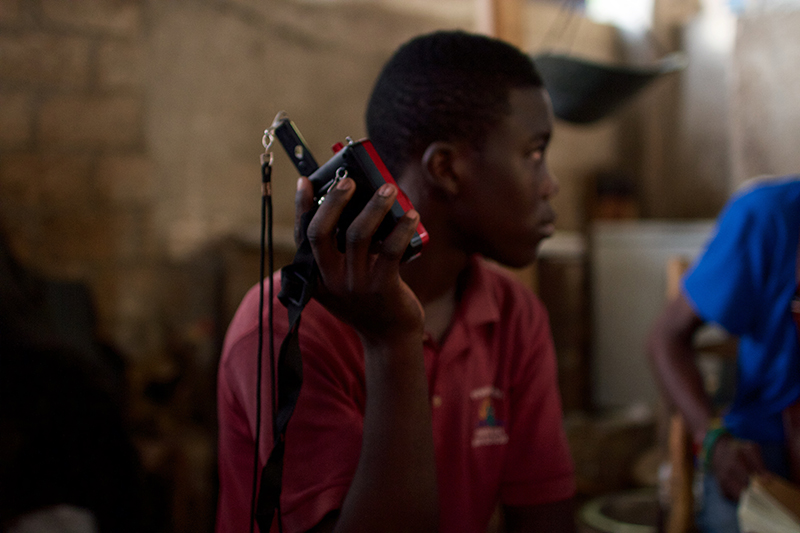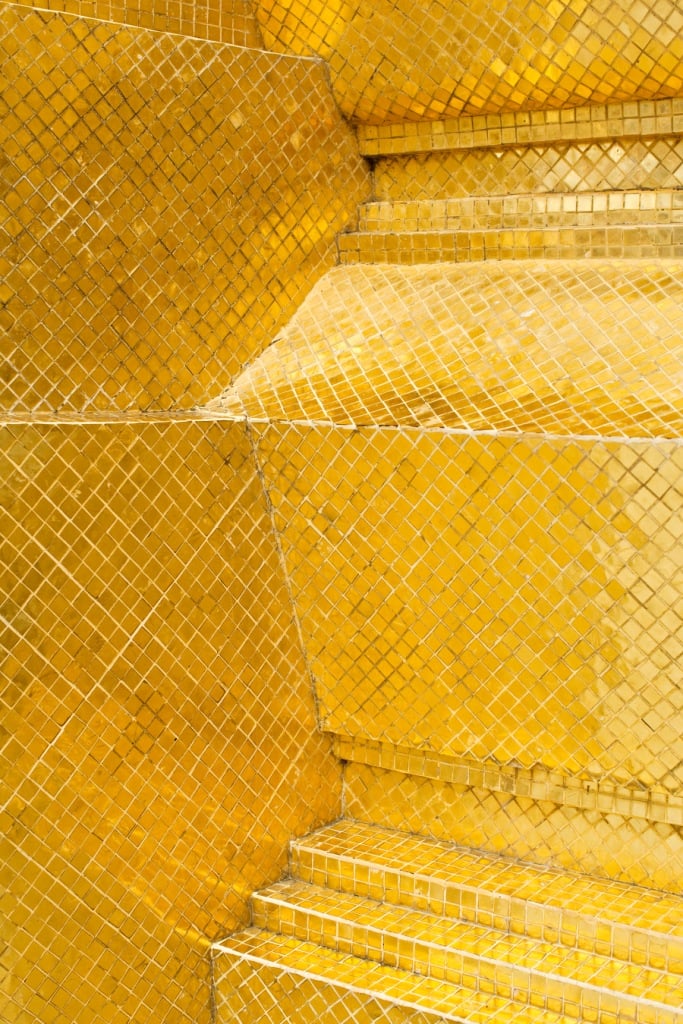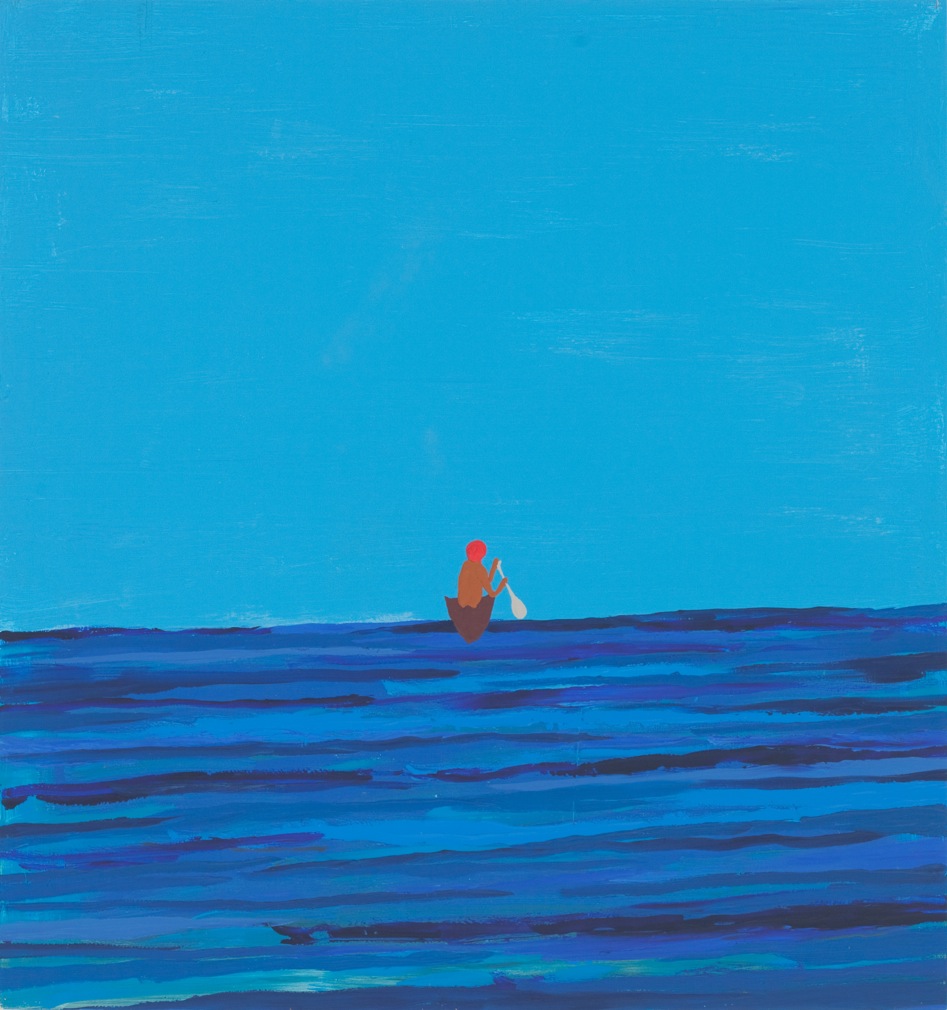
© » KADIST
Curtis Talwst Santiago
Curtis Talwst Santiago has been creating intimate and performative environments within these small spaces for several years; the artist used to carry them around to show visitors one on one, opening up a scene in the space of his hand. Santiago considers these mobile box enclosures a method of transporting narratives of home and intimacy, diasporic identity, and experiences most often hidden or concealed from view. These Walls is a sculptural piece made from a reclaimed jewelry box, clay, paint, wool, plastic figurines, and human hair.

© » KADIST
Santiago Yahuarcani
Drawing & Print (Drawing & Print)
The series Castigos del caucho by Santiago Yahuarcani originates in the oral memory transmitted by the artist’s grandfather, who was a survivor of the Putumayo genocide where thousands of Indigenous people were annihilated and enslaved to extract rubber from the Amazon forest between 1879 and 1912. Yahuarcani’s complex narrative paintings on tree bark highlight a long history of colonial violence against the Uitoto and other Indigenous communities. They also show the destruction of the rainforest under Western models of extraction, privatization, and development.

© » KADIST
Reyes Santiago Rojas
The work Sarta (String) by Reyes Santiago Roja is part of a larger series of works that examine the commercialization of the tobacco plant and its relationship to the meaning and use of tobacco by Native American tribes such as the Mayas, Aztecs, Incas or Tainos, which attributed spiritual qualities to tobacco such as the smoke carrying one’s thoughts and prayers to the sprits. In this work the artist studied the forms of tobacco leaves native to Latin America and recreated their shapes with commercial tobacco packaging from such global brands as Marlboro or Camel to the most popular Colombian brand Pielroja. The leaves made of the packaging material are lined up on a string as if they are hung out to dry as in traditional tobacco making processes.

© » KADIST
Santiago Borja
Cosmic Tautology I and II are two textile pieces representative of Santiago Borja’s practice and long-standing interest in disrupting universalist assumptions of minimalism by connecting them with other, non-Western or esoteric references. They were hand-woven in Teotitlán del Valle, Oaxaca, Mexico, and are composed of nine squares, the middle one left unwoven. Their composition is based on Red Square, White Letters (1962) by Sol Lewit, but they also take cues from works like Black Series II by Frank Stella.

© » KADIST
Chris Huen Sin-Kan
Contrast to the bustling and unrelenting experience of a city such as Hong Kong, Chris Huen Sin Kan paints the tranquil interiors of his apartment, where he leads a modest and almost hermit-like life. He does not try to capture a particular moment, but rather the simultaneously changes that occur before him in time, exploring the nuances of light and reflections and recording movements in his apartment, his dog’s behavior and reactions, the way his plant change over time, all in an attempt to find a visual expression of his cognitive experience. Doodood and John are the names of his dog and the plant.

© » KADIST
Beatriz Santiago Muñoz
Another curious element is that it seemed that I was seeing images from the dreams I had that afternoon. But these images were appearing from end to beginning, like a film reel running backwards. I also couldn’t properly situate them.

© » KADIST
Beatriz Santiago Muñoz
Marché Salomon by Beatriz Santiago Muñoz depicts two meat vendors, a young man and woman, chatting in Marché Salomon, a busy Port-au-Prince market. Amongst the surrounding bustle, the two have an unsentimental discussion about the mystical qualities of common products sold at the market, wondering whether the divine can inhabit any kind of object—mass produced bottles, toxic rivers, beheaded goats. Their musings weave together the cosmic and the mundane, with the work of butchering a goat and the characters of the market serving as existential metaphors for the universe, time travel, ghosts, and death.

© » KADIST
Beatriz Santiago Muñoz
La cabeza mató a todos or “The Head that Killed Everyone”, is a mixing of indigenous mythologies with present-day characters, geographies, and culture in Puerto Rico. The title refers to how a shooting star was (in local mythology) interpreted as a head without a body, crossing the sky, signaling the arrival of chaos and destruction. The actor in the video, Michelle Nonó, is in touch with native plants—she’s a medicinal botanist but also a cultural activist.

© » KADIST
Sam Contis
Sam Contis’s photographs explore the relationship of bodies to landscape, and the shifting nature of gender identity and expression. Horseback is part of a photographic series Contis made at Deep Springs College, one of the United States’s last all-male institutions of higher learning, located in a remote desert valley on the California–Nevada border. Horseback is a black and white photograph that depicts the arched shoulders of a horse, its slick mane splayed across its neck.

© » KADIST
Sam Contis
Sam Contis’s photographs explore the relationship of bodies to landscape, and the shifting nature of gender identity and expression. Oil is part of a photographic series Contis made at Deep Springs College, one of the United States’s last all-male institutions of higher learning, located in a remote desert valley on the California–Nevada border. Oil features a hand in front of an open hood of a car, checking the oil.

© » KADIST
Chris Duncan
Taken from the title of the incredibly influential punk/hardcore record I AGAINST I by the Bad Brains, Untitled (blue) is an acrylic painting on reflective paper by Chris Duncan is part of a larger body of work titled EYE AGAINST I . This title references Duncan’s early artistic influences from the punk and hardcore music communities in tandem with his conceptual interest in perception and optics. This small painting features a glowing cluster of colorful dots on a bright blue background, also created from an accumulation of blue dots in varying tones.

© » KADIST
Chris Wiley
Architectural details become abstracted renderings in Chris Wiley’s inkjet prints 11 and 20 (both 2012). In photographing seemingly mundane images of doorways and walls, Wiley collapses the viewer’s experience of inhabiting space by foregrounding features that we all too often miss in our built environment: the peeling white paint on a Corinthian column or the rusty studs on a blue door.

© » KADIST
Chris Johanson
Chris Johanson’s paintings, sculptures, and installations break down everyday scenes and commonplace dramas into colorful forms; the darkest sides of humanity are invoked with humor. The works comment on subjects such as capitalism, consumerism, the art world, and therapy. The triptych I Am a Human, Abstract Foil, No Humans IV (2004) is a meditation on the cosmos.

© » KADIST
Chris Johanson
Apartment on Cardboard (2000) is an exterior view of an abstracted apartment building. Viewers unwittingly become voyeurs, peering through the rectangles that stand for windows and observing the residents therein, who ponder questions both mundane and existential: “Where is Ron now?” and “What have I become?” The queries and characters are treated democratically—not judged, praised, or subjected to hierarchy. While their thoughts are specific, the painting captures a universal urban activity: looking across to the building next door and wondering about its residents, all the while knowing that they have probably looked over and wondered about us, as well.

© » KADIST
Chris Wiley
Architectural details become abstracted renderings in Chris Wiley’s inkjet prints 11 and 20 (both 2012). In photographing seemingly mundane images of doorways and walls, Wiley collapses the viewer’s experience of inhabiting space by foregrounding features that we all too often miss in our built environment: the peeling white paint on a Corinthian column or the rusty studs on a blue door.

© » KADIST
Chris Johanson
Chris Johanson’s Untitled (Painting of a Man Leaving in Boat) (2010) pictures a canoe drifting toward an off-kilter horizon line, which demarcates the cobalt sea from the cerulean sky. An orange-haired figure, oar positioned in mid-stroke, looks ahead—whether toward an edge or an infinite expanse, it is impossible to tell. Echoing a trope that recurs in Greek epic poetry, transcendental painting, and current-day reality television, the character is alone with nature.
Chris Johanson
- location: Los Angeles, California
- year born: 1968
- gender: male
- nationality: American
- home town: San Jose, California
Chris Wiley
- location: New York, New York
- year born: 1981
- gender: male
- nationality: British
Chris Duncan
Chris Duncan employs repetition and accumulation as a basis for experiments in visual and sound-based media...
Santiago Yahuarcani
Santiago Yahuarcani belongs to the Aimen+ (White Heron) clan of the Uitoto people of the northern Amazon...
Reyes Santiago Rojas
Reyes Santiago Rojas works with themes relates to nature, patience and garbage...
Chris Huen Sin-Kan
Chris Huen Sin-Kan (b...
Santiago Borja
Santiago Borja’s work explores improbable connections between different thought systems, thus emphasizing the cannibalistic nature of modernism, and its inherently esoteric, yet seemingly “rational”, character...
Curtis Talwst Santiago
Curtis Talwst Santiago is a multimedia artist making work centered on the diasporic experience, transculturalism, and memory...
Chris Ofili
- location: Manchester, United Kingdom
- year born: 1968
- gender: male
- nationality: British

© » APERTURE
about 5 months ago (12/06/2023)
In her photographs of England's stiles and centuries-old footpaths, the artist reflects on how we cross boundaries—and the ways we have shaped the natural world....
-
2000-2009
Chris Johanson
2000Apartment on Cardboard (2000) is an exterior view of an abstracted apartment building...
Chris Johanson
2004Chris Johanson’s paintings, sculptures, and installations break down everyday scenes and commonplace dramas into colorful forms; the darkest sides of humanity are invoked with humor...
-
2010-2019
Chris Duncan
2010Taken from the title of the incredibly influential punk/hardcore record I AGAINST I by the Bad Brains, Untitled (blue) is an acrylic painting on reflective paper by Chris Duncan is part of a larger body of work titled EYE AGAINST I ...
Chris Johanson
2010Chris Johanson’s Untitled (Painting of a Man Leaving in Boat) (2010) pictures a canoe drifting toward an off-kilter horizon line, which demarcates the cobalt sea from the cerulean sky...
Santiago Borja
2012Cosmic Tautology I and II are two textile pieces representative of Santiago Borja’s practice and long-standing interest in disrupting universalist assumptions of minimalism by connecting them with other, non-Western or esoteric references...
Chris Wiley
2012Architectural details become abstracted renderings in Chris Wiley’s inkjet prints 11 and 20 (both 2012)...
Chris Wiley
2012Architectural details become abstracted renderings in Chris Wiley’s inkjet prints 11 and 20 (both 2012)...
Chris Huen Sin-Kan
2013Contrast to the bustling and unrelenting experience of a city such as Hong Kong, Chris Huen Sin Kan paints the tranquil interiors of his apartment, where he leads a modest and almost hermit-like life...
Beatriz Santiago Muñoz
2013Another curious element is that it seemed that I was seeing images from the dreams I had that afternoon...
Beatriz Santiago Muñoz
2014La cabeza mató a todos or “The Head that Killed Everyone”, is a mixing of indigenous mythologies with present-day characters, geographies, and culture in Puerto Rico...
Sam Contis
2014Sam Contis’s photographs explore the relationship of bodies to landscape, and the shifting nature of gender identity and expression...
Sam Contis
2014Sam Contis’s photographs explore the relationship of bodies to landscape, and the shifting nature of gender identity and expression...
Reyes Santiago Rojas
2015The work Sarta (String) by Reyes Santiago Roja is part of a larger series of works that examine the commercialization of the tobacco plant and its relationship to the meaning and use of tobacco by Native American tribes such as the Mayas, Aztecs, Incas or Tainos, which attributed spiritual qualities to tobacco such as the smoke carrying one’s thoughts and prayers to the sprits...
Beatriz Santiago Muñoz
2015Marché Salomon by Beatriz Santiago Muñoz depicts two meat vendors, a young man and woman, chatting in Marché Salomon, a busy Port-au-Prince market...
Curtis Talwst Santiago
2017Curtis Talwst Santiago has been creating intimate and performative environments within these small spaces for several years; the artist used to carry them around to show visitors one on one, opening up a scene in the space of his hand...
Santiago Yahuarcani
Drawing & Print
2017(Drawing & Print) The series Castigos del caucho by Santiago Yahuarcani originates in the oral memory transmitted by the artist’s grandfather, who was a survivor of the Putumayo genocide where thousands of Indigenous people were annihilated and enslaved to extract rubber from the Amazon forest between 1879 and 1912...
